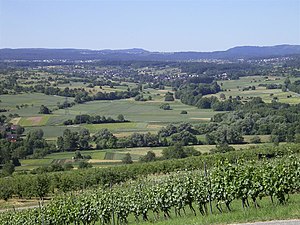Pressed fruit and grapevine region
|
Landscape protection area "Kelterner Obst- und Rebengäu"
|
||
|
View through the Ellmendinger vineyards to the upper Pfinztal |
||
| location | Four communities in the Enzkreis in Baden-Württemberg , Germany | |
| surface | 21.968 km² | |
| Identifier | 2.36.038 | |
| WDPA ID | 323804 | |
| Geographical location | 48 ° 54 ' N , 8 ° 33' E | |
|
|
||
| Setup date | March 15, 1983 | |
| administration | District Office Enzkreis | |
Kelterner Obst- und Rebengäu is a protected landscape area in the Enzkreis (protected area number 2.36.038).
Location and description
The approximately 2,197 hectare landscape protection area was created by ordinance of the Enzkreis District Office of March 15, 1983. When this ordinance came into force, the Pforzheim District Office's ordinance on the protection of parts of the landscape in the Dietlingen and Nöttingen districts of August 17, 1962 (Ranntal landscape protection area) came into effect this referred to parts of the municipality of Keltern and the ordinance of the Enzkreis district office on the Römerberg landscape protection area of February 20, 1974, expired.
The protected area consists of four sub-areas and includes the entire municipality of Keltern with the exception of the built-up areas with some development areas and two nature reserves. It is on the mark of four parishes:
- Pressing = 2192.7726 ha, 99.81%
- Birkenfeld = 2.8225 ha, 0.12%
- Remchingen = 0.9884 ha, 0.04%
- Kämpfelbach = 0.181 ha, 0.01%
It belongs to the natural areas 125- Kraichgau and 150- Black Forest edge plates within the natural spatial main units 12- Neckar- and Tauber-Gäuplatten and 15- Black Forest . Several landscape protection areas follow. A small part of the protected area is in FFH area No. 7017-341 Pfinzgau Ost . The nature reserves 2020- Essigberg and 2125- Ellmendinger Roggenschleh border directly on the landscape protection area.
Protection purpose
According to the Protected Area Ordinance, the main protection purpose is conservation
- the near-natural cultural landscape typical of the Pfinzhügelland in the transition area between shell limestone and upper red sandstone;
- the meadows and pastures with their orchards;
- the field corridor structured by ravines, hedge trains, individual trees, small forest units and creeks. The hedgerows, individual trees, field trees, fruit trees, rains and near-natural forests, as well as the vegetation of the abandoned quarries and the ravines are important as biological cells and as refuges for the flora and fauna that are important for the stability of the natural balance. They also represent an effective protection against erosion by water and wind;
- all forest stands, succession areas and woody plants, especially deciduous and mixed forests;
- the wetlands, in particular wetlands and litter meadows as well as sedge and reed stands;
- Large-scale contiguous parts of the landscape, which, due to their diverse natural features, represent the particularly varied type of the Gäu landscape in the Pfinzhügelland, as an ecological balance and as a recreational area for the neighboring and congested areas of Karlsruhe-Pforzheim-Stuttgart.
See also
Web links
- Profile of the landscape protection area in the protected area directory of the LUBW



